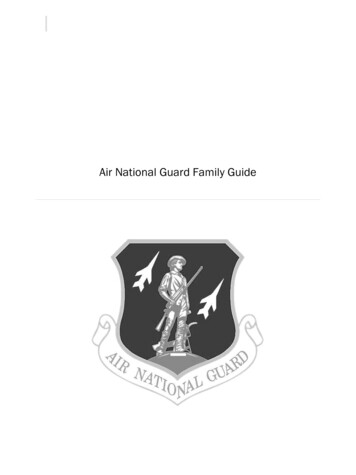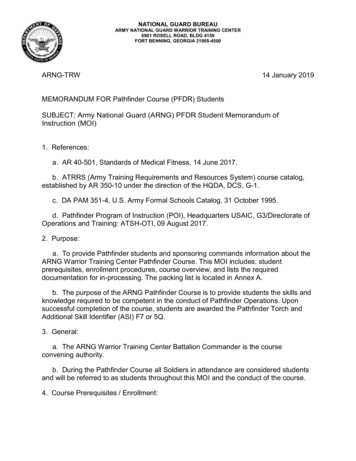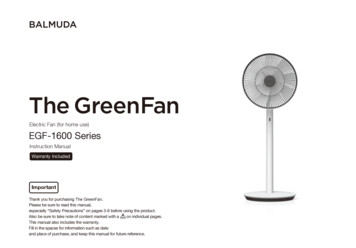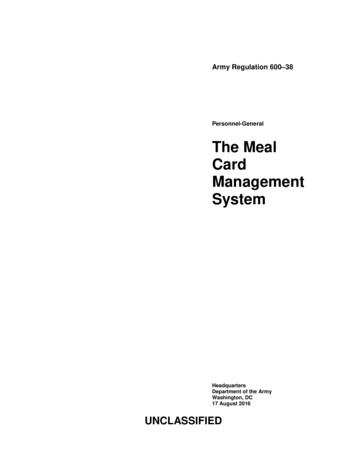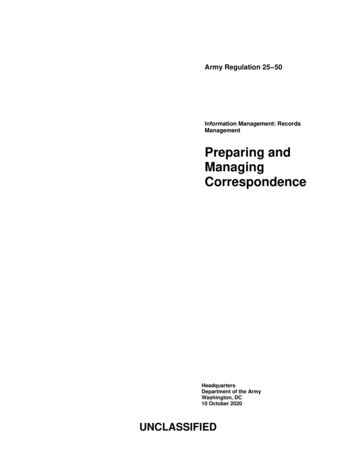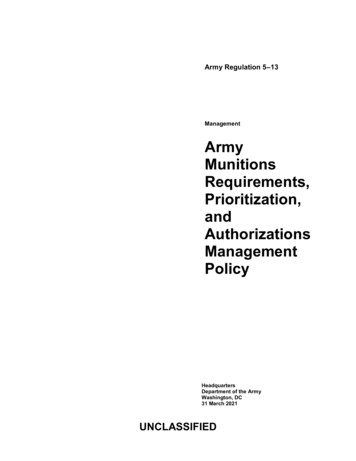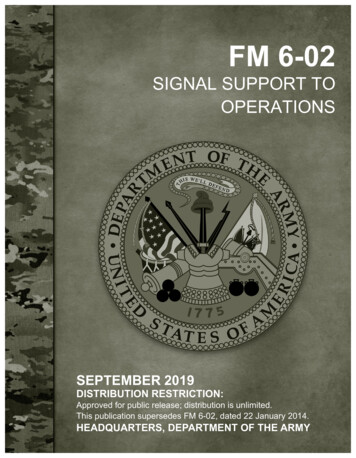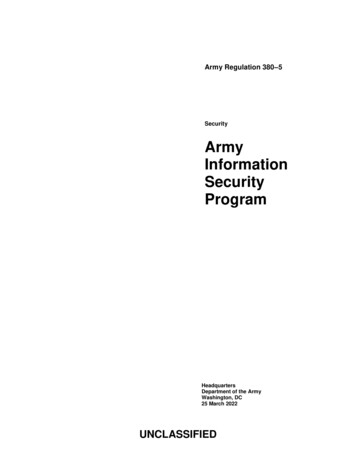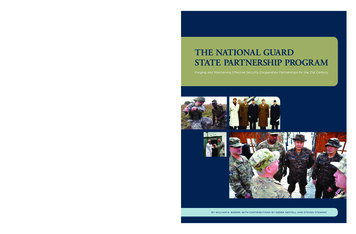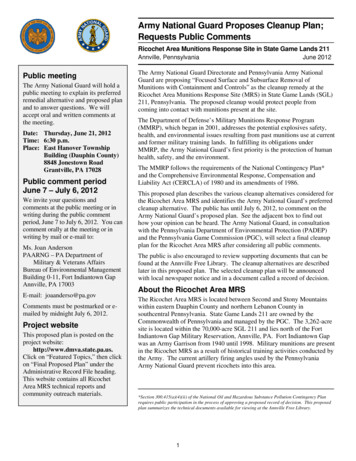
Transcription
Army National Guard Proposes Cleanup Plan;Requests Public CommentsRicochet Area Munitions Response Site in State Game Lands 211Annville, PennsylvaniaJune 2012Public meetingThe Army National Guard will hold apublic meeting to explain its preferredremedial alternative and proposed planand to answer questions. We willaccept oral and written comments atthe meeting.Date: Thursday, June 21, 2012Time: 6:30 p.m.Place: East Hanover TownshipBuilding (Dauphin County)8848 Jonestown RoadGrantville, PA 17028Public comment periodJune 7 – July 6, 2012We invite your questions andcomments at the public meeting or inwriting during the public commentperiod, June 7 to July 6, 2012. You cancomment orally at the meeting or inwriting by mail or e-mail to:Ms. Joan AndersonPAARNG – PA Department ofMilitary & Veterans AffairsBureau of Environmental ManagementBuilding 0-11, Fort Indiantown GapAnnville, PA 17003E-mail: joaanderso@pa.govComments must be postmarked or emailed by midnight July 6, 2012.Project websiteThis proposed plan is posted on theproject website:http://www.dmva.state.pa.us.Click on “Featured Topics,” then clickon “Final Proposed Plan” under theAdministrative Record File heading.This website contains all RicochetArea MRS technical reports andcommunity outreach materials.The Army National Guard Directorate and Pennsylvania Army NationalGuard are proposing “Focused Surface and Subsurface Removal ofMunitions with Containment and Controls” as the cleanup remedy at theRicochet Area Munitions Response Site (MRS) in State Game Lands (SGL)211, Pennsylvania. The proposed cleanup would protect people fromcoming into contact with munitions present at the site.The Department of Defense’s Military Munitions Response Program(MMRP), which began in 2001, addresses the potential explosives safety,health, and environmental issues resulting from past munitions use at currentand former military training lands. In fulfilling its obligations underMMRP, the Army National Guard’s first priority is the protection of humanhealth, safety, and the environment.The MMRP follows the requirements of the National Contingency Plan*and the Comprehensive Environmental Response, Compensation andLiability Act (CERCLA) of 1980 and its amendments of 1986.This proposed plan describes the various cleanup alternatives considered forthe Ricochet Area MRS and identifies the Army National Guard’s preferredcleanup alternative. The public has until July 6, 2012, to comment on theArmy National Guard’s proposed plan. See the adjacent box to find outhow your opinion can be heard. The Army National Guard, in consultationwith the Pennsylvania Department of Environmental Protection (PADEP)and the Pennsylvania Game Commission (PGC), will select a final cleanupplan for the Ricochet Area MRS after considering all public comments.The public is also encouraged to review supporting documents that can befound at the Annville Free Library. The cleanup alternatives are describedlater in this proposed plan. The selected cleanup plan will be announcedwith local newspaper notice and in a document called a record of decision.About the Ricochet Area MRSThe Ricochet Area MRS is located between Second and Stony Mountainswithin eastern Dauphin County and northern Lebanon County insouthcentral Pennsylvania. State Game Lands 211 are owned by theCommonwealth of Pennsylvania and managed by the PGC. The 3,262-acresite is located within the 70,000-acre SGL 211 and lies north of the FortIndiantown Gap Military Reservation, Annville, PA. Fort Indiantown Gapwas an Army Garrison from 1940 until 1998. Military munitions are presentin the Ricochet MRS as a result of historical training activities conducted bythe Army. The current artillery firing angles used by the PennsylvaniaArmy National Guard prevent ricochets into this area.*Section 300.415(a)(4)(ii) of the National Oil and Hazardous Substance Pollution Contingency Planrequires public participation in the process of approving a proposed record of decision. This proposedplan summarizes the technical documents available for viewing at the Annville Free Library.1
The topography of the Ricochet Area is a valley andridge system. Ridgeline elevations range from 1,200 to1,400 ft for Second Mountain, which marks the southernboundary of the MRS. Stony Mountain ridgelineelevations range from 1,610 to 1,670 ft. Stony Creekflows from northeast to southwest in the valley betweenthe two ridgelines.recreational activities, including game land maintenance,special wildlife area management at herbaceousopenings, and timber management. Herbaceousopenings (food plots) are regularly maintained for wildgame such as turkey and deer.Timber harvests are also periodically conducted withinSGL 211. Locations of harvests are selected based ontimber surveys/inventories to identify manageable timberand areas for potential habitat improvement projects.The Ricochet Area MRS contains a variety of coniferdominated forests to mixed deciduous forests. Forestedwetland areas are interspersed along many of the seepsand springs located throughout the MRS and along theStony Creek stream corridor.Nature and extent of MEC contaminationThe Ricochet Area was initially identified during the siteinventory study conducted in 2003. The area identifiedin the study spanned 8,002 acres and included a potentialricochet zone associated with an artillery impact areaand an overlapping range fan extending from a formerfiring point located within the Cold Spring portion of thesite. Based on the results of the study, it was determinedthat the site was eligible under the MMRP.A diverse mix of mammals, birds, reptiles, amphibians,insects, and benthic macroinvertebrates are supported bythe habitat present within the Ricochet Area MRS. Thereare no known federally listed threatened or endangeredplant or wildlife species that occur within the RicochetArea MRS. Potential special status species present includethe following insects: Hand-Maid Moth, Pine BarrensZale, and Black Dash. Terrestrial wildlife special statusspecies include the Indiana Bat, Allegheny Wood Rat, andTimber Rattlesnake. Special status plant species includethe Minniebush, Netted Chainfern, and American Holly.A site inspection (SI) was conducted between 2007 and2008 to determine if munitions were present at the site.Although no munitions items were identified during theSI, historical reports document recovered inert projectiles,illumination canisters, and a live World War II highexplosive Sherman tank round. Soil samples collectedfrom the MRS during the SI did not indicate significantconcentrations of munitions constituents. Based on pastdiscoveries of these munitions, the Ricochet Area wasassigned an MRS score of 2, the second highest priorityunder the MMRP. The MRS was recommended for afollow-on remedial investigation (RI).While, there are no registered cultural or historicresources identified within the MRS, the area has a richhistorical heritage. Numerous foundations from formerhomesteads, other structures associated with the ColdSpring Hotel and former railroad bed are present withinthe site. Human settlement in the MRS dates back toearly 1820’s when a tavern was established at ColdSprings. Coal mining and the rail road service wereestablished through this area in the mid 1840s. The ColdSpring Hotel was established in 1850. The area was alsoextensively timbered in the late 1800s. The decline ofcommercial mining and timbering was followed by adevelopment of the area for recreational purposesincluding a sportsmen’s club, spring water bottlingoperations, and a YMCA camp also occupied the easternportion of the MRS from 1924-1942. Around WorldWar II time frame the railroad ceased operation and thetracks were removed. In addition, the U.S. Army usedportions of this area as a bivouac and firing point in the1940s and 1950s.The RI field work was initiated in 2009 to determine thenature (type) and extent (distribution) of munitions andexplosives of concern (MEC), including unexplodedordnance (UXO), discarded military munitions (DMM),and munitions constituents (MC). Geophysical transectand grid surveys were performed on a statisticallyrepresentative portion of the 8,002-acre site tocharacterize and constrain the distribution of MEC,munitions debris (MD), and MC in soil. Geophysicalsurveys conducted along transects and grids covered atotal of 374 acres.To assess the presence of MC, soil samples were collectedand analyzed for explosives (e.g., TNT) and metals.Current land use includes a number of recreationalactivities such as fishing, hunting, hiking, running,bicycle riding, snow shoeing, dog-sledding, crosscountry skiing, snowmobiling, horseback riding, FallDrive-Thru, and bird watching. The Horse-Shoe Trailand Appalachian National Scenic Trail are adjacent tothe MRS. Non-recreational activities within the MRSinclude trail, game, and forest maintenance performed byPGC employees or their contractors.A total of 134 munitions items (121 MD and 13 MEC)were removed from the site and/or destroyed during theRI. The following items, intact, partially intact, and/orfragments, were recovered: There are no plans to change the current land use. Thesite will continue to be used for recreational and non237-mm (millimeters) projectiles57-mm projectiles60-mm mortars81-mm mortars75-mm projectiles 105-mm projectiles4.2-inch mortars155-mm projectiles165-mm projectilesMK-2A4 primers
Ricochet Area Munitions Response SiteThe majority of these items were larger caliber 75-mmand 105-mm projectiles or canisters. Most of the itemsrecovered (58%) were considered wholly inert munitionsthat never had energetic components. Forty-one percent(41%) of the items previously had energetic componentsbut no energetic materials remained upon discovery.Only one percent (1%) of the items found was MECwith residual explosive constituents and representing anexplosive hazard. The MEC included: containers, rotating band covers and lifting lugs, wasalso found buried at Cold Spring firing point.Analytical results for soil samples collected at MEClocations showed no significant MC detections.Explosives and munitions-related metals concentrationswere not detected above background levels or PADEPstandards. The human health risk assessment concludedthat no remedial action was necessary for MC to protectpublic health, welfare, or the environment based on thecurrent and intended future use of the site (i.e.,recreational visitors and site workers). The ecological riskassessment concluded that the potential risk from MC insoil to populations (i.e., plants and wildlife) is low.One 155-mm high explosive projectile.Seven 75-mm high explosive projectiles.One 75-mm armor piercing high explosive projectile.Four MK-2A4 primers.The projected density of MEC and MD at the site isestimated at less than 1 to 9 items per acre. ResidualMEC at the site is considered an explosives safety hazard.It is possible for the public to come into contact withMEC through handling or unintentional disturbance.Residual MD at the site is also considered a safety hazardsince the general public cannot differentiate an explosivemunition from an inert one. It is important to note thatunless documented or certified as safe by a UXOtechnician, all munitions items are considered anexplosive safety threat and a risk to the public.In addition to the 134 munitions items, 594 man-madecultural debris items (i.e., railroad spikes, nails, metal scrap,horseshoes, and wire) were recovered. None of these itemswere assessed to be culturally and/or historically significant.Items of interest were inspected and donated to localmuseums and interested community members.All MEC and MD were recovered within a 3,262-acrearea between the Stony Creek valley and the ridgeline ofSecond Mountain as shown in the figure above. Noevidence of MEC or MD was found from the southernslope of Sharp Mountain extending north to StonyMountain’s ridgeline. Approximately 66% of the MECand MD were located at the ground surface. The fourprimers were found at the former Cold Spring firingpoint at a depth of 12 inches below ground surface.Additional range-related debris, including fuze shippingThe Ricochet Area MRS boundary was reduced duringthe RI to include only the area that was found to containMEC and MD. The new MRS is 3,262 acres in size.Results from the RI also identified several areas totaling1,334 acres within the MRS that have a higherprobability for encountering MEC.3
A feasibility study was preparedafter the RI report was finalized inJuly 2011. A feasibility study is adetailed analysis that developsviable cleanup alternatives andexamines the pros and cons ofapplying the alternatives to aspecific MRS. Five cleanupalternatives were developed andanalyzed as part of the RicochetArea MRS feasibility study, whichwas finalized in January 2012.Remedial action objectivesThe Ricochet Area MRS current andfuture land use is primarily outdoorrecreational activities by theresidents of Lebanon and DauphinCounties, including hunting, biking,fishing, and hiking. PGCemployees also access the MRSroutinely for maintenance.The goal of a cleanup alternative isto reduce explosives safety risk atthe Ricochet Area MRS and toensure protection of human health,public safety, and the environment.To achieve this goal, objectiveswere established to minimize MECexposure to the following: The public while maintainingaccess for recreational activities.PGC personnel at herbaceousopenings maintained for turkeyand deer.PGC personnel and contractorsduring timber harvesting activities.Explanation of the nine evaluation criteriaThe Comprehensive Environmental Response, Compensation, and Liability Actrequires the evaluation of each cleanup alternative to address the following ninecriteria:1. Overall Protection of Human Health and the Environment – Evaluateswhether a cleanup alternative provides adequate protection and evaluateshow risks are eliminated, reduced, or controlled through treatment,engineering controls, or local government controls.2. Compliance with Applicable or Relevant and Appropriate Requirements –Evaluates whether a cleanup option meets federal and state environmentallaws, regulations, and other requirements or justifies any waivers.3. Long‐Term Effectiveness and Permanence – Considers any remaining risksafter cleanup is complete and the ability of a cleanup option to maintainreliable protection of human health and the environment over time oncecleanup goals are met.4. Reduction of Toxicity, Mobility, or Volume through Treatment – Evaluates acleanup option’s use of treatment to reduce the harmful effects of thecontaminants, their ability to move in the environment, and the amount ofcontamination present.5. Short‐Term Effectiveness – Considers the time needed to clean up a site andthe risks a cleanup option may pose to workers, the community, and theenvironment until the cleanup goals are met.6. Implementability – The technical and administrative feasibility ofimplementing a cleanup option, including factors such as the relativeavailability of goods and resources.7. Cost – Includes estimated capital and annual operations and maintenancecosts as well as the present worth cost. (Present worth cost is the total cost ofan alternative over time in terms of today’s dollar value.)8. State Acceptance – Considers whether the state (Commonwealth ofPennsylvania) agrees with the National Guard’s analyses andrecommendations as described in the proposed plan.9. Community Acceptance – Considers whether the local community agreeswith the National Guard’s analyses and proposed cleanup plan. Thecomments the National Guard receives on its preferred alternative areimportant indicators of community acceptance.users; signs placed at game lands to notify the public ofexplosive safety hazards when encountering munitions;notifications included with permits and contracts;information added to existing printed materials; and anawareness video provided to groups and organizationsusing the game lands. Cost - 181,998Cleanup alternativesThe Army National Guard considered five differentalternatives for cleaning up the Ricochet Area MRS. Allalternatives were evaluated against nine criteria requiredby the Superfund law (see criteria explanation in the boxon this page). The five alternatives are summarizedbelow, but full details are available in the technicaldocuments on file at the Annville Free Library.Alternative 3 – Surface Removal of Munitions withContainment and Controls Removal of MECdetected on the ground surface across the entire 3,262acre Ricochet Area MRS. This alternative also includescontainment and controls similar to those presented inAlternative 2. Cost - 16,182,335Alternative 1 - No Action No Action is provided as abaseline for comparison to the other proposed alternatives.This alternative means no action will be taken to locate,remove, and dispose of munitions. Cost - 0Alternative 4 – Focused Surface and SubsurfaceRemoval of Munitions with containment andControls (Army National Guard’s PreferredAlternative) Removal of MEC detected on the groundsurface in the area identified (see figure on page 3) withmore than 0.5 MEC and MD per acre and along trailsAlternative 2 – Containment and Controls Consistsof various access control and/or public awarenesscomponents. Examples of containment and controls arebrochures and fact sheets distributed to recreational4
removed from two herbaceous openings. This completeclearance will reduce potential explosives hazards resultingfrom plowing and disking by PGC personnel who maintainthese openings. And lastly, UXO construction support woulbe provided as needed during timber management activities,such as constructing access roads and establishing loglandings. This will remove the surface and subsurfaceMEC/MD that would be encountered during these operationbut specific to the areas where timber will be harvested.(estimated to be 1,334 acres of the Ricochet Area MRS).This alternative includes removal of MEC to detectiondepth at the herbaceous openings. This alternative alsoincludes containment and controls, including MECconstruction support as needed during timbermanagement activities. Cost - 6,757,826Alternative 6 - Removal of Munitions to DetectionDepth with Containment and Controls Removal ofMEC detected across the entire 3,262-acre RicochetArea MRS to instrument detection depth. Thisalternative also includes containment and controlssimilar to Alternative 2. Cost - 24,315,156Alternatives 1 and 2 are not desirable because they do notremove any MEC or MD. Alternative 3 covers a larger areathan Alternative 4 but does not address subsurface MEC.Additionally, Alternative 3 is more expensive thanAlternative 4 but may not provide additional benefit based oncurrent and future land use. Alternative 5 is the mostprotective remedy but also the most expensive. In addition, itwould result in the largest amount of disturbance to theenvironment and impact to special status species. Alternative4 will have a lesser degree of disturbance to the environmentthan Alternative 5. Coupled with outreach efforts to mitigatethe public’s encounter with MEC/MD, it is estimated that theMEC and MD removal conducted for Alternative 4, will fullyaddress the explosive safety risk, locate and remove most ofthe MEC/MD, and provide the most cost effective solutionfor cleaning up the Ricochet Area MRS.Evaluation of alternativesThe Army National Guard evaluated the various cleanupalternatives against seven of the nine evaluation criteria(see box on this page). The state and communityacceptance criteria will be evaluated after publiccomments are received. More detailed information aboutthe evaluation can be found in the Feasibility Study Reportfor Ricochet Area Munitions Response Site in State GameLands 211, Pennsylvania. For the cleanup of the RicochetArea MRS, the Army National Guard’s preferred choiceis Alternative 4 - Focused Surface and SubsurfaceRemoval of Munitions with Containment and Controls.Evaluating cleanup alternatives againstnine evaluation criteriaAlternative 4 focuses on locations where there is thehighest probability of encountering MEC and MD on theground surface. By implementing Alternative 4, it isanticipated that most of the MEC and MD at the MRSwill be located and removed. Therefore, this alternativewill reduce exposure risks inherent during recreationalactivities performed by the public and maintenanceactivities performed by PGC personnel.The Army National Guard evaluated the cleanupalternatives against seven of the nine evaluation criteria.(see “Explanation of evaluation criteria” on page 4).The state regulator and community acceptance criteriawill be evaluated after public comments are received bythe Army National Guard. The degree to which cleanupalternatives meet the evaluation criteria as determined byCERCLA is shown in the table below.In addition to the surface removal in the higher MEC/MDdensity of the MRS, surface and subsurface MEC would beEvaluation of cleanup alternativesEvaluation CriteriaAlternative 1Alternative 2Alternative 3PreferredAlternative 4 181,998 16,182,335 6,757,826 24,315,1565.Short‐term effectiveness6.Implementability 7.Cost 08.9.State regulator acceptanceCommunity acceptance1.2.3.4.Overall protection of humanhealth and the environmentCompliance with applicable orrelevant and appropriaterequirementsLong‐term effectiveness andpermanenceReduction of toxicity, mobility orvolume through treatment Favorable, meets criteriaWill be evaluated after public comment period.Will be evaluated after public comment period. Moderately favorable Not favorable, does not meet criteria5Alternative 5
cleanup plan is available in the documents on file at theAnnville Free Library and on the project website(website address is provided on page 1). The ArmyNational Guard will respond in writing to comments in aresponsiveness summary that will be part of the finaldecision document called the record of decision. Oncefinalized, the Army National Guard will announce theselected cleanup plan in a local newspaper advertisementand place a copy of the record of decision in theadministrative record file at the Annville Free Library.Next steps(The Army National Guard in consultation with PADEPand PGC will evaluate public reaction to the preferredcleanup alternative during the comment period and thepublic meeting before deciding on the final remedy.Based on new information or public comments, theArmy National Guard may modify its proposedalternative or select another cleanup alternative outlinedin this proposed plan. The Army National Guardencourages you to review and comment on the cleanupalternatives. More technical detail on the proposedThe Army National Guard Directorate andPennsylvania Army National Guardpropose a preferred cleanup alternativefor the Ricochet Area Munitions Response Sitein State Game Lands 211, PennsylvaniaImportant community meeting scheduled forJune 21, 20126
Proposed PlanRicochet Area Munitions Response Site in State Game Lands 211, PennsylvaniaUse This Space to Write Your CommentsYour input on the proposed plan is important to the Army National Guard.Comments provided by the public are valuable in helping us select a finalremedy for the site.You may use the space below to write your comments and mail. Useadditional paper if needed. Comments must be postmarked or e-mailed bymidnight July 6, 2012. If you have any questions about the public commentprocess, please contact Ms. Joan Anderson, Pennsylvania Army NationalGuard, joaanderso@pa.gov, (717) 861-8181, or Mr. Rob Halla, ArmyNational Guard Directorate, rob.halla@us.army.mil, (703) 607-7995.Mail your comments to:Ms. Joan AndersonPAARNG – PA Department ofMilitary & Veterans AffairsBureau of Environmental ManagementBuilding 0-11, Fort Indiantown GapAnnville, PA 17003Or e-mail your comments to:joaanderso@pa.govNameAffiliationAddressCity, State, Zip
Recoognizze RettreattReccognize whhen you maymhavve encounttered amunnition.Recoognizing wheen you may havehencoountered a munition is theemostt important sttep in reducingthe riskrof injury oro death.Muniitions may bee encountereedon laand or in the water.wTheyymay be easy or hardhto identiffy.To avoid risk of innjury or death: Never move, touchNtor distuurb ammunitionor suuspect munitioon Be aware thaBat munitions dodn become safernotswith age, inffactthey mayy become mooreddangerous Don’t be tempDpted to take orokkeepa munitiion as a souvvenirMuniitions come in many sizess,shappes, and coloors. Some maylook like bullets oro bombs whiilepsmall canscotherrs look like pipes,or evven a car muffler. Whetherwhole or in parts,, new or old,unitions can stillshinyy or rusty, muexploode.Do not touuch, movee, orddisturbit; but careffullyleave the area.AAvoiddeath or injury byrrecognizingtthatyou mayy haveeencountereda munition andappromptlyretrreating from thet area.If you encounnter what youu believei a munition, do not touchish move,o disturb it. Instead, immormediatelya carefullyy leave the areandea byrretracingyouur steps gooing outo the way yoofou entered. OnceOssafelyaway fromfthe munnition,mmarkthe pathh (e.g., with a pieceo clothing orr GPS coordinofnates)s response personnel casoan findt munition.theReporte rtImmeddiately nottify thepolice.Protect yourself,yyourr family, yourfriends, anda your commmunity byimmediaately reportingg munitions orrsuspecteed munitions to the police.Help thee police by prroviding asmuch infformation as possibleabout whhat you saw and whereyou saww it. This will help thepolice annd military orr civilianexplosivves ordnancee disposalpersonnel find, evaluuate, andn.address the situationelieve you maay haveIf you beencountered a munittion, call 911ort:and repo The area where youyountered it.enco Its general descrription.member: do notnRemapprroach, touch,, move, ordistuurb it. Wheen possible, provide:p IIts estimatedd sizeI shapeItsA visible markings,Anymiincludingcolooring57-mm artilleery projectile37-mm artilleery projectile75-mm high expplosive projecttiles
and the Pennsylvania Game Commission (PGC), will select a final cleanup plan for the Ricochet Area MRS after considering all public comments. The public is also encouraged to review supporting documents that can be found at the Annville Free Library. The cleanup alternatives are described later in this proposed plan.
